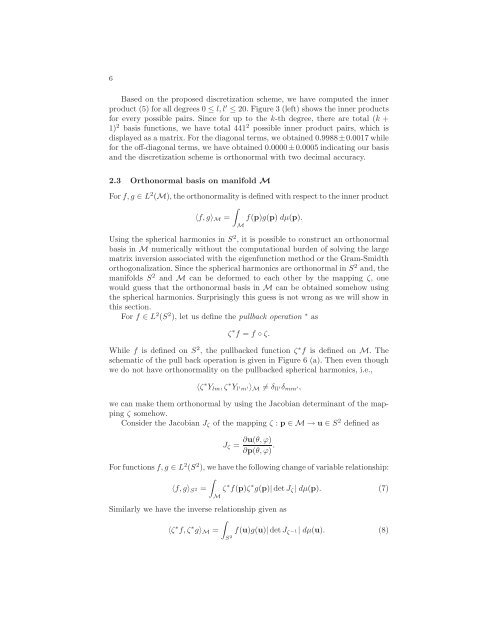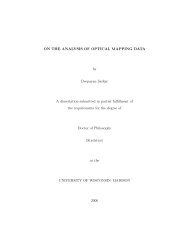Tiling Manifolds with Orthonormal Basis - Department of Statistics ...
Tiling Manifolds with Orthonormal Basis - Department of Statistics ...
Tiling Manifolds with Orthonormal Basis - Department of Statistics ...
Create successful ePaper yourself
Turn your PDF publications into a flip-book with our unique Google optimized e-Paper software.
6<br />
Based on the proposed discretization scheme, we have computed the inner<br />
product (5) for all degrees 0 ≤ l, l ′ ≤ 20. Figure 3 (left) shows the inner products<br />
for every possible pairs. Since for up to the k-th degree, there are total (k +<br />
1) 2 basis functions, we have total 441 2 possible inner product pairs, which is<br />
displayed as a matrix. For the diagonal terms, we obtained 0.9988 ±0.0017 while<br />
for the <strong>of</strong>f-diagonal terms, we have obtained 0.0000 ±0.0005 indicating our basis<br />
and the discretization scheme is orthonormal <strong>with</strong> two decimal accuracy.<br />
2.3 <strong>Orthonormal</strong> basis on manifold M<br />
For f, g ∈ L 2 (M), the orthonormality is defined <strong>with</strong> respect to the inner product<br />
∫<br />
〈f, g〉 M = f(p)g(p) dµ(p).<br />
M<br />
Using the spherical harmonics in S 2 , it is possible to construct an orthonormal<br />
basis in M numerically <strong>with</strong>out the computational burden <strong>of</strong> solving the large<br />
matrix inversion associated <strong>with</strong> the eigenfunction method or the Gram-Smidth<br />
orthogonalization. Since the spherical harmonics are orthonormal in S 2 and, the<br />
manifolds S 2 and M can be deformed to each other by the mapping ζ, one<br />
would guess that the orthonormal basis in M can be obtained somehow using<br />
the spherical harmonics. Surprisingly this guess is not wrong as we will show in<br />
this section.<br />
For f ∈ L 2 (S 2 ), let us define the pullback operation ∗ as<br />
ζ ∗ f = f ◦ ζ.<br />
While f is defined on S 2 , the pullbacked function ζ ∗ f is defined on M. The<br />
schematic <strong>of</strong> the pull back operation is given in Figure 6 (a). Then even though<br />
we do not have orthonormality on the pullbacked spherical harmonics, i.e.,<br />
〈ζ ∗ Y lm , ζ ∗ Y l′ m ′〉 M ≠ δ ll ′δ mm ′,<br />
we can make them orthonormal by using the Jacobian determinant <strong>of</strong> the mapping<br />
ζ somehow.<br />
Consider the Jacobian J ζ <strong>of</strong> the mapping ζ : p ∈ M → u ∈ S 2 defined as<br />
J ζ =<br />
∂u(θ, ϕ)<br />
∂p(θ, ϕ) .<br />
For functions f, g ∈ L 2 (S 2 ), we have the following change <strong>of</strong> variable relationship:<br />
∫<br />
〈f, g〉 S 2 = ζ ∗ f(p)ζ ∗ g(p)| detJ ζ | dµ(p). (7)<br />
M<br />
Similarly we have the inverse relationship given as<br />
∫<br />
〈ζ ∗ f, ζ ∗ g〉 M = f(u)g(u)| detJ ζ −1| dµ(u). (8)<br />
S 2
















